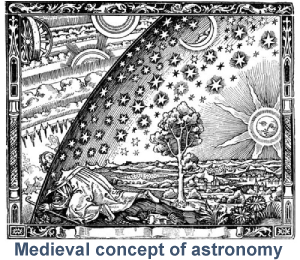|
 The Sun rises in the east, sets in the west, and appears to circle around the Earth. The planets, the Moon, and the stars have similar apparent motion. Early theories of astronomy put Earth at the center of the universe with celestial objects circling around it. Ptolemy (AD 90–AD 168) is credited with the model illustrated in the Flammarion on the right in which an explorer reaching the edge of Earth peers out from under the first, and lowest, celestial sphere containing the sky, clouds, and air.
The Sun rises in the east, sets in the west, and appears to circle around the Earth. The planets, the Moon, and the stars have similar apparent motion. Early theories of astronomy put Earth at the center of the universe with celestial objects circling around it. Ptolemy (AD 90–AD 168) is credited with the model illustrated in the Flammarion on the right in which an explorer reaching the edge of Earth peers out from under the first, and lowest, celestial sphere containing the sky, clouds, and air. 
|
Nicolaus Copernicus (1473–1543) correctly deduced that the planets revolve around the Sun, which is called the heliocentric model. Nonetheless, Copernicus was not widely believed at any time during his life. Danish nobleman Tycho Brahe (1546–1601) made the first accurate and systematic measurements of the positions of stars and planets over many years, aided by his assistant Johannes Kepler (1571–1630). A brilliant mathematical thinker, Kepler laboriously worked with Brahe’s data long after Brahe’s death, and in 1609 he published the first of what are now known as Kepler’s laws of planetary motion. In Kepler’s laws, the gravitational force between the Sun and a planet determines the properties of the orbit of the planet. 
|

 |
What radius does the R refer to in Kepler’s third law? In a circular orbit, it is simply the radius of the circle. In an elliptical orbit, this R equals one half of the longest dimension of the ellipse. This distance is called the semi-major axis. 
|
 In 1610 Italian philosopher Galileo Galilei turned his newly made telescope upon Jupiter and observed four “stars” near the planet. Over a period of a few days these “stars” changed their positions, as Galileo’s notes in his journal show clearly. Galileo correctly deduced that these were in fact not stars orbiting Earth, but four moons orbiting Jupiter. These Galilean moons provided the first clear observational evidence that not all celestial objects circle around the Earth.
In 1610 Italian philosopher Galileo Galilei turned his newly made telescope upon Jupiter and observed four “stars” near the planet. Over a period of a few days these “stars” changed their positions, as Galileo’s notes in his journal show clearly. Galileo correctly deduced that these were in fact not stars orbiting Earth, but four moons orbiting Jupiter. These Galilean moons provided the first clear observational evidence that not all celestial objects circle around the Earth. 
|
Though it took 200 years to become accepted by society, the Sun-centered solar system forever changed how humans think. Prior to the Renaissance, the correctness of ideas was based on tradition and reasoning—even incorrect reasoning. Kepler, Galileo, Newton, and others ushered in a new way of thinking where truth is based on what is actually seen, heard, and demonstrated. This is the essence of the modern view of science: that truth is what actually happens, not what people think should happen. 
|
| |
|

